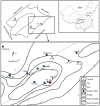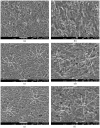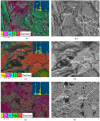Experimental Investigation of Mechanical Properties of Black Shales after CO₂-Water-Rock Interaction
- PMID: 28773784
- PMCID: PMC5509274
- DOI: 10.3390/ma9080663
Experimental Investigation of Mechanical Properties of Black Shales after CO₂-Water-Rock Interaction
Abstract
The effects of CO₂-water-rock interactions on the mechanical properties of shale are essential for estimating the possibility of sequestrating CO₂ in shale reservoirs. In this study, uniaxial compressive strength (UCS) tests together with an acoustic emission (AE) system and SEM and EDS analysis were performed to investigate the mechanical properties and microstructural changes of black shales with different saturation times (10 days, 20 days and 30 days) in water dissoluted with gaseous/super-critical CO₂. According to the experimental results, the values of UCS, Young's modulus and brittleness index decrease gradually with increasing saturation time in water with gaseous/super-critical CO₂. Compared to samples without saturation, 30-day saturation causes reductions of 56.43% in UCS and 54.21% in Young's modulus for gaseous saturated samples, and 66.05% in UCS and 56.32% in Young's modulus for super-critical saturated samples, respectively. The brittleness index also decreases drastically from 84.3% for samples without saturation to 50.9% for samples saturated in water with gaseous CO₂, to 47.9% for samples saturated in water with super-critical carbon dioxide (SC-CO₂). SC-CO₂ causes a greater reduction of shale's mechanical properties. The crack propagation results obtained from the AE system show that longer saturation time produces higher peak cumulative AE energy. SEM images show that many pores occur when shale samples are saturated in water with gaseous/super-critical CO₂. The EDS results show that CO₂-water-rock interactions increase the percentages of C and Fe and decrease the percentages of Al and K on the surface of saturated samples when compared to samples without saturation.
Keywords: CO2-water-rock interaction; crack propagation; mechanical properties; microstructure; shale.
Conflict of interest statement
The authors declare no conflict of interest.
Figures








Similar articles
-
Evolution Characteristics of Mechanical Properties under Supercritical Carbon Dioxide Treatment in Shale Reservoirs.ACS Omega. 2021 Jan 6;6(4):2813-2823. doi: 10.1021/acsomega.0c05136. eCollection 2021 Feb 2. ACS Omega. 2021. PMID: 33553899 Free PMC article.
-
Short-term interactions between Longmaxi shale and carbon dioxide-based fracturing fluids.Heliyon. 2024 Sep 27;10(19):e38575. doi: 10.1016/j.heliyon.2024.e38575. eCollection 2024 Oct 15. Heliyon. 2024. PMID: 39403484 Free PMC article.
-
Insights into the Effect of Spontaneous Fluid Imbibition on the Formation Mechanism of Fracture Networks in Brittle Shale: An Experimental Investigation.ACS Omega. 2020 Apr 7;5(15):8847-8857. doi: 10.1021/acsomega.0c00452. eCollection 2020 Apr 21. ACS Omega. 2020. PMID: 32337447 Free PMC article.
-
Acoustic emission and fractal characteristics of red beds soft rock under water-force coupling.Sci Rep. 2024 Feb 23;14(1):4424. doi: 10.1038/s41598-024-54814-2. Sci Rep. 2024. PMID: 38388765 Free PMC article.
-
Young's modulus of trabecular bone at the tissue level: A review.Acta Biomater. 2018 Sep 15;78:1-12. doi: 10.1016/j.actbio.2018.08.001. Epub 2018 Aug 4. Acta Biomater. 2018. PMID: 30081232 Review.
Cited by
-
Different Effect Mechanisms of Supercritical CO2 on the Shale Microscopic Structure.ACS Omega. 2020 Aug 24;5(35):22568-22577. doi: 10.1021/acsomega.0c03200. eCollection 2020 Sep 8. ACS Omega. 2020. PMID: 32923816 Free PMC article.
-
A review of carbon mineralization mechanism during geological CO2 storage.Heliyon. 2023 Dec 2;9(12):e23135. doi: 10.1016/j.heliyon.2023.e23135. eCollection 2023 Dec. Heliyon. 2023. PMID: 38149201 Free PMC article. Review.
-
The permeability of shale exposed to supercritical carbon dioxide.Sci Rep. 2023 Apr 25;13(1):6734. doi: 10.1038/s41598-023-33702-1. Sci Rep. 2023. PMID: 37185792 Free PMC article.
-
Development and Application of Carbonate Dissolution Test Equipment under Thermal-Hydraulic-Chemical Coupling Condition.Materials (Basel). 2022 Oct 21;15(20):7383. doi: 10.3390/ma15207383. Materials (Basel). 2022. PMID: 36295447 Free PMC article.
-
Evolution Characteristics of Mechanical Properties under Supercritical Carbon Dioxide Treatment in Shale Reservoirs.ACS Omega. 2021 Jan 6;6(4):2813-2823. doi: 10.1021/acsomega.0c05136. eCollection 2021 Feb 2. ACS Omega. 2021. PMID: 33553899 Free PMC article.
References
-
- Bachu S., Bonijoly D., Bradshaw J., Burruss R., Holloway S., Christensen N.P., Mathiassen O.M. CO2 storage capacity estimation: Methodology and gaps. Int. J. Greenh. Gas Control. 2007;1:430–443. doi: 10.1016/S1750-5836(07)00086-2. - DOI
-
- Dahaghi A.K. Numerical simulation and modeling of enhanced gas recovery and CO2 sequestration in shale gas reservoirs: A feasibility study; Proceedings of the SPE International Conference on CO2 Capture, Storage, and Utilization; New Orleans, LA, USA. 10–12 November 2010.
-
- Liu F., Ellett K., Xiao Y., Rupp J.A. Assessing the feasibility of CO2 storage in the New Albany Shale (Devonian-Mississippian) with potential enhanced gas recovery using reservoir simulation. Int. J. Greenh. Gas Control. 2013;17:111–126. doi: 10.1016/j.ijggc.2013.04.018. - DOI
-
- Chen Z., Liao X., Zhao X., Feng X., Zang J., He L. A new analytical method based on pressure transient analysis to estimate carbon storage capacity of depleted shales: A case study. Int. J. Greenh. Gas Control. 2015;42:46–58. doi: 10.1016/j.ijggc.2015.07.030. - DOI
-
- Gunter W., Wiwehar B., Perkins E. Aquifer disposal of CO2-rich greenhouse gases: Extension of the time scale of experiment for CO2-sequestering reactions by geochemical modelling. Mineral. Petrol. 1997;59:121–140. doi: 10.1007/BF01163065. - DOI
LinkOut - more resources
Full Text Sources
Other Literature Sources

